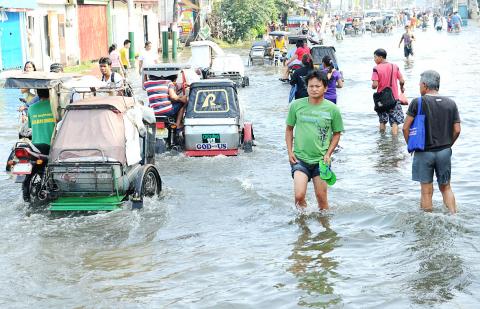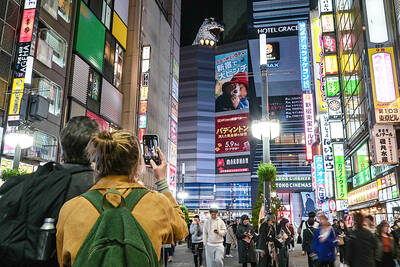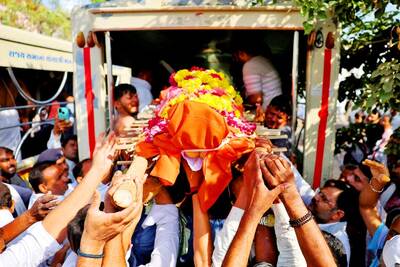Deadly floods, power blackouts and traffic gridlock — many of Asia’s biggest cities are buckling under the strain of rapid economic development, extreme weather and an exodus from the countryside.
Poor strategic planning, paltry investment in infrastructure and a lack of political will have also left the region’s overcrowded metropolises highly vulnerable to the pressures of climate change, experts say.
Over the past year, Bangkok and Manila have been hit by the most devastating floods in decades, while India recently suffered the world’s worst-ever power blackout due to surging demand from industry, homes and offices.

Photo: AFP
It is a situation that is increasingly out of step with growing affluence in Asia, where millions of people escape from poverty every year but face a return to third-world conditions when disaster strikes.
Many Asian cities are “lagging behind in infrastructure provision, whether we talk about sewers, roads or electricity supplies,” said Sun Sheng Han, an urban planning expert at Australia’s University of Melbourne.
At the heart of the problem lies a lack of vision in a region where urban development policies reflect a mixture of “political goals and economic ambitions,” he said.
In the Thai capital Bangkok, years of aggressive groundwater extraction to meet the growing needs of its factories and 12 million inhabitants have taken a heavy toll.
Yet despite warnings the city — built on swampland and slowly sinking — risks being below sea level in half a century from now, a building boom shows no sign of abating with apartment towers mushrooming around the city.
Rapid urbanization that blocks natural waterways and neglected drainage systems are also seen as major factors behind the deadly floods that have battered the Philippine capital Manila this month.
On the outskirts of Manila, vital forested areas have been destroyed to make way for housing developments catering to growing middle and upper classes.
Within the city, squatters — attracted by economic opportunities — often build shanties on river banks, storm drains and canals, dumping garbage and impeding the flow of waterways.
However, perhaps nowhere are the challenges more stark than in India, where a two-day power blackout across half the country last month left more than 600 million people without supplies as high demand overwhelmed the grid.
Yet even now, only 30 percent of India’s 1.2 billion population live in cities, far lower than the 50.6 percent in China or the 70 to 80 percent in developed countries, according to a UN report released last year.
It forecasts India’s urban population will grow by 60 percent from its current level of 377 million, to 606 million, by 2030.
As air conditioners, microwave ovens, washing machines and other electrical items become increasingly popular with the country’s burgeoning middle class, the strains on the power sector are expected to increase.
According to the McKinsey Global Institute research center, India also needs 350km to 400km of new metros and subways a year and 19,000km to 25,000km of roads.
Mumbai — with 20,000 inhabitants per square kilometer — is one of the world’s most densely populated cities.
Its packed suburban trains are estimated to carry 7 million people every day, and each year more than 3,000 people are killed on the railway network, sometimes falling from open doors or hit while crossing the tracks.
“The rush hour is the biggest issue. There are times it’s so crowded, it’s difficult to breathe,” said Sudhir Gadgil, 62, an office assistant in Mumbai’s southern business district, whose commute to work by train takes one-and-a-half hours.
In neighboring Bangladesh, the capital Dhaka is facing the worst transport infrastructure problems in its history.
Soon after taking over in January 2009, the government promised to tackle the crisis with an array of ambitious rail, bus and road projects, but most are still in the design stage.
“Dhaka already is a moribund city. It’s dying fast and I see no hope how we can save it,” said Shamsul Haq, the country’s top transport expert and a professor at Bangladesh University of Engineering and Technology.
However, traffic jams are by no means unique to Bangladesh, and in many teeming cities the prospect of abandoning city life altogether is becoming increasingly appealing for some frustrated residents.
In Jakarta, ranked bottom of 23 cities in Frost & Sullivan’s 2011 global commuter satisfaction survey, experts predict that given its ageing bus network and lack of train system, the capital will reach total gridlock by 2014.
“If it doesn’t change in the next five years, I’m moving to Bali for a more peaceful life,” freelance writer Dian Agustino said in one of the city’s shopping malls.

POLITICAL PRISONERS VS DEPORTEES: Venezuela’s prosecutor’s office slammed the call by El Salvador’s leader, accusing him of crimes against humanity Salvadoran President Nayib Bukele on Sunday proposed carrying out a prisoner swap with Venezuela, suggesting he would exchange Venezuelan deportees from the US his government has kept imprisoned for what he called “political prisoners” in Venezuela. In a post on X, directed at Venezuelan President Nicolas Maduro, Bukele listed off a number of family members of high-level opposition figures in Venezuela, journalists and activists detained during the South American government’s electoral crackdown last year. “The only reason they are imprisoned is for having opposed you and your electoral fraud,” he wrote to Maduro. “However, I want to propose a humanitarian agreement that

ECONOMIC WORRIES: The ruling PAP faces voters amid concerns that the city-state faces the possibility of a recession and job losses amid Washington’s tariffs Singapore yesterday finalized contestants for its general election on Saturday next week, with the ruling People’s Action Party (PAP) fielding 32 new candidates in the biggest refresh of the party that has ruled the city-state since independence in 1965. The move follows a pledge by Singaporean Prime Minister Lawrence Wong (黃循財), who took office last year and assumed the PAP leadership, to “bring in new blood, new ideas and new energy” to steer the country of 6 million people. His latest shake-up beats that of predecessors Lee Hsien Loong (李顯龍) and Goh Chok Tong (吳作棟), who replaced 24 and 11 politicians respectively

Young women standing idly around a park in Tokyo’s west suggest that a giant statue of Godzilla is not the only attraction for a record number of foreign tourists. Their faces lit by the cold glow of their phones, the women lining Okubo Park are evidence that sex tourism has developed as a dark flipside to the bustling Kabukicho nightlife district. Increasing numbers of foreign men are flocking to the area after seeing videos on social media. One of the women said that the area near Kabukicho, where Godzilla rumbles and belches smoke atop a cinema, has become a “real

‘WATER WARFARE’: A Pakistani official called India’s suspension of a 65-year-old treaty on the sharing of waters from the Indus River ‘a cowardly, illegal move’ Pakistan yesterday canceled visas for Indian nationals, closed its airspace for all Indian-owned or operated airlines, and suspended all trade with India, including to and from any third country. The retaliatory measures follow India’s decision to suspend visas for Pakistani nationals in the aftermath of a deadly attack by shooters in Kashmir that killed 26 people, mostly tourists. The rare attack on civilians shocked and outraged India and prompted calls for action against their country’s archenemy, Pakistan. New Delhi did not publicly produce evidence connecting the attack to its neighbor, but said it had “cross-border” links to Pakistan. Pakistan denied any connection to